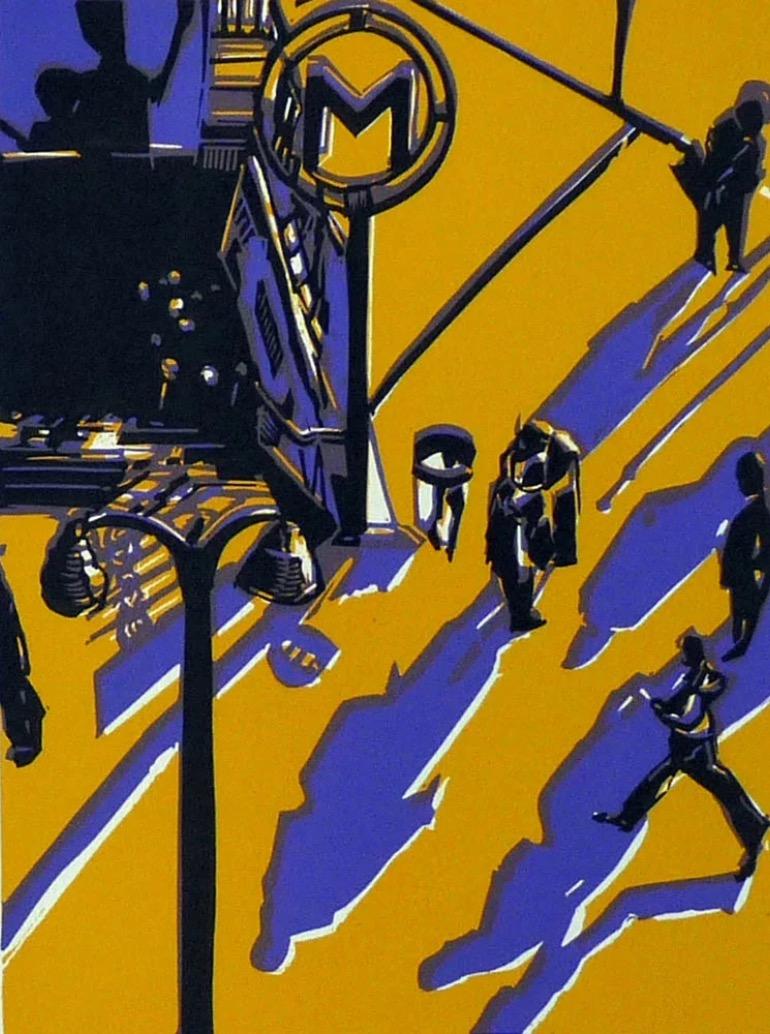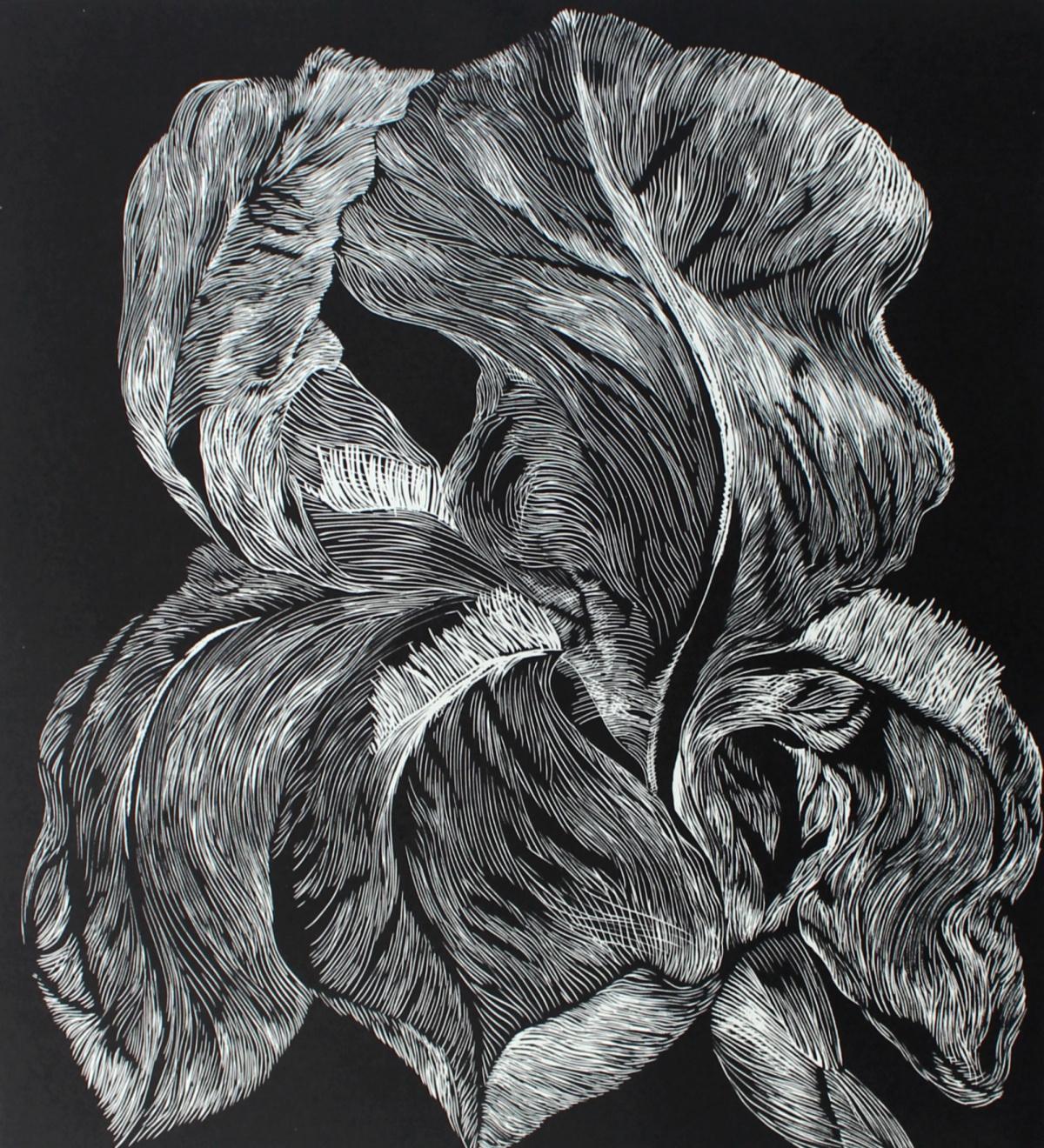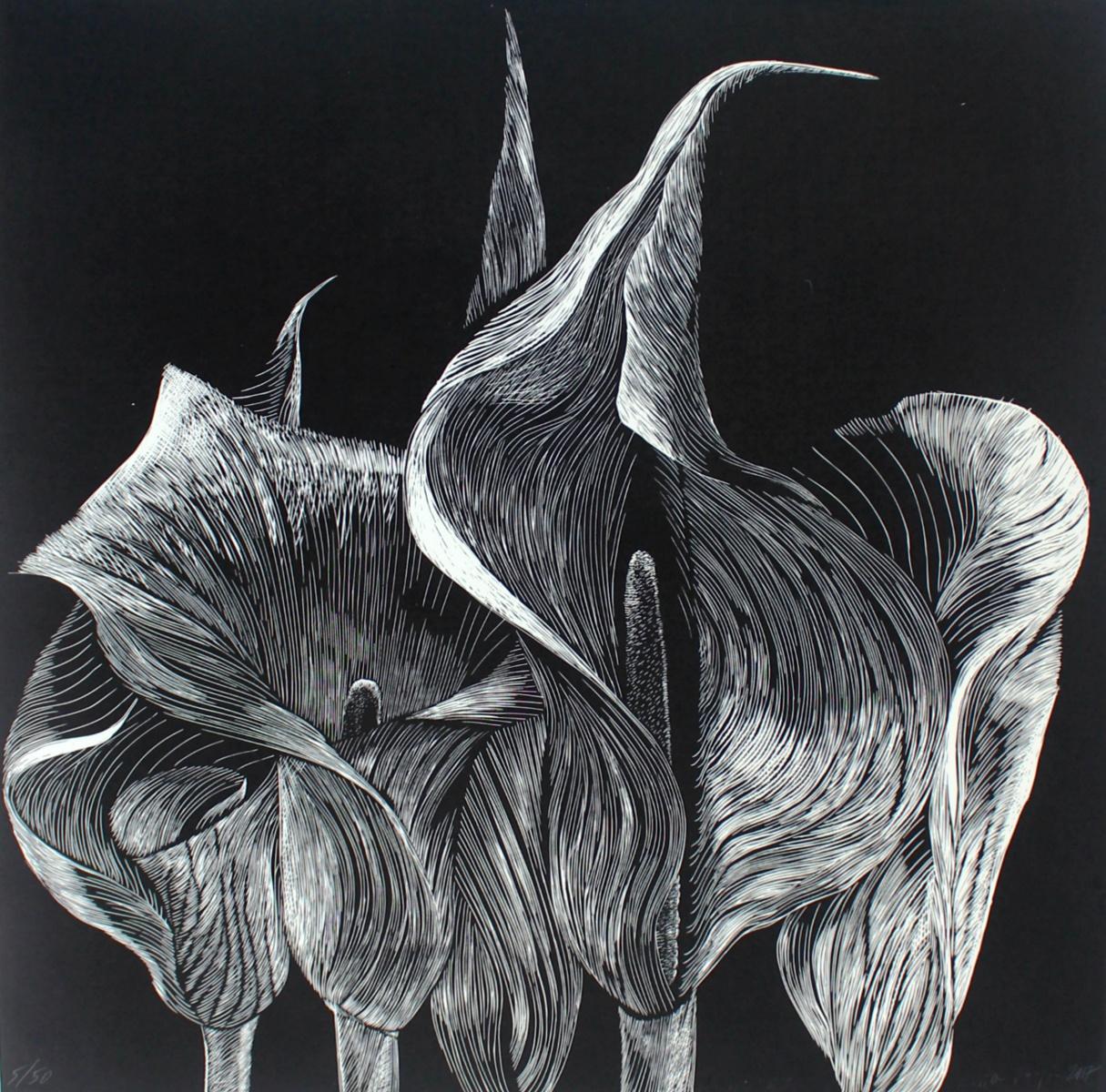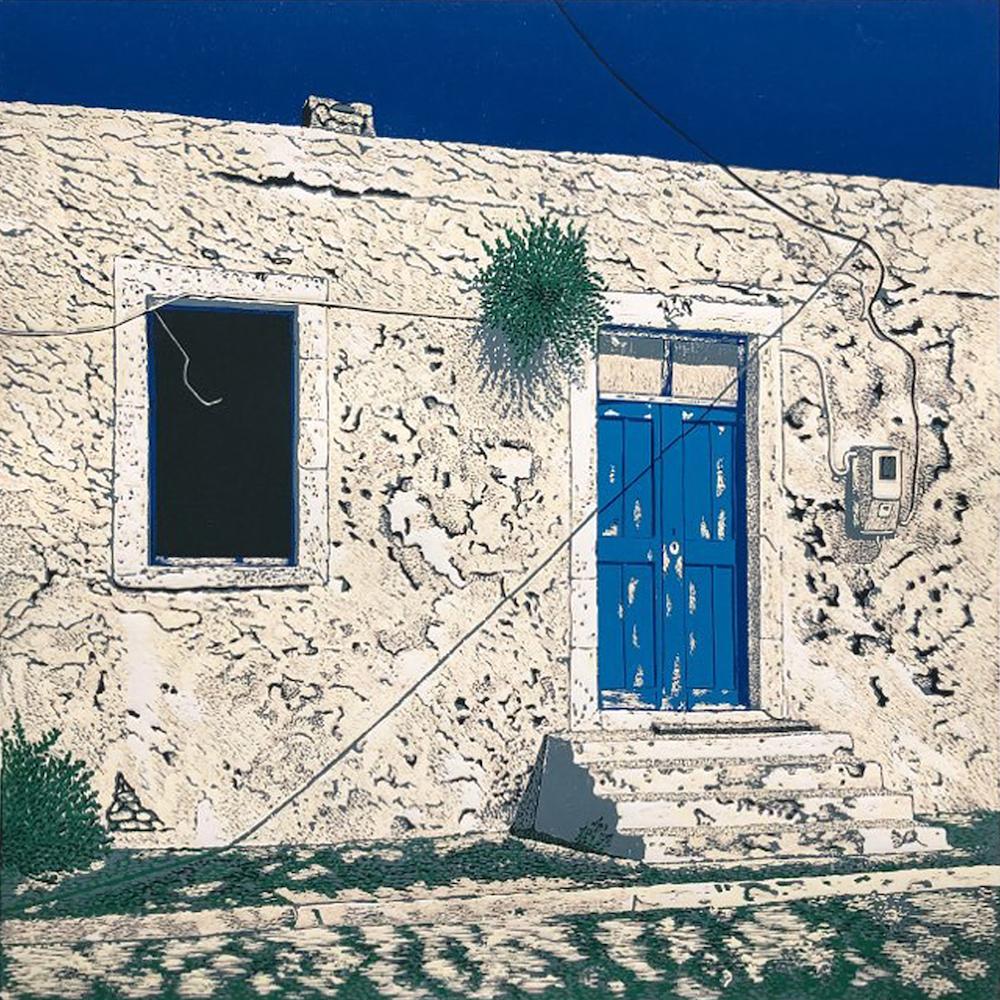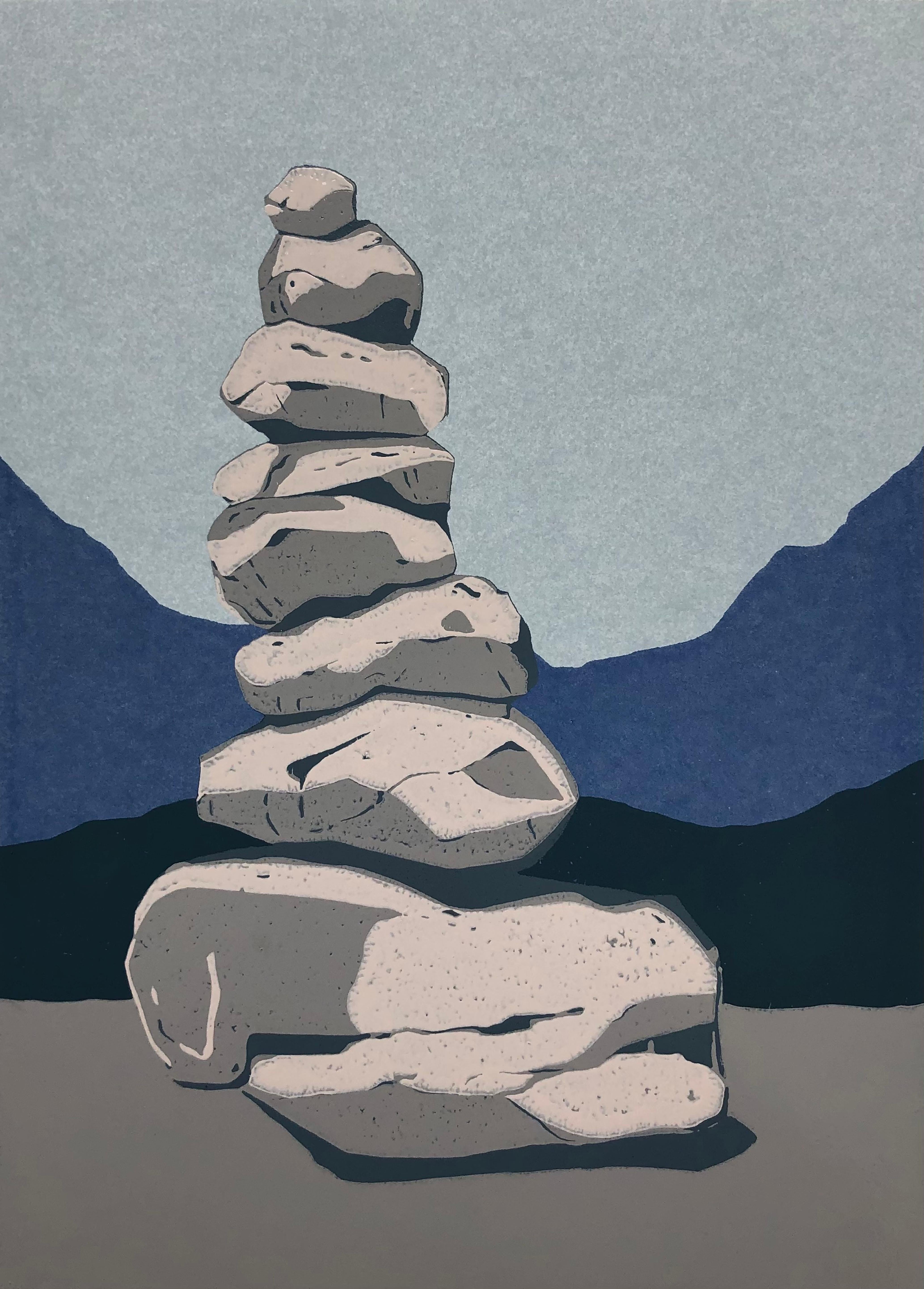David Barnett"The Fence, Private Keep Out, " Original Linocut on Yellow Paper by David Barnett1967
1967
About the Item
- Creator:David Barnett (1933, American)
- Creation Year:1967
- Dimensions:Height: 11 in (27.94 cm)Width: 18.5 in (46.99 cm)
- Medium:
- Movement & Style:
- Period:
- Framing:Frame IncludedFraming Options Available
- Condition:
- Gallery Location:Milwaukee, WI
- Reference Number:
David Barnett
David Barnett, an artist, collector, appraiser and gallerist has been passionate about art from the early age of five. David’s career as an art dealer began at age 19 when, as a fine arts student, he sponsored an exhibition of work by fellow student artists. In 1966, he opened his first gallery in a converted basement apartment at Wisconsin Avenue and 21st Street. In 1985, David moved his gallery from Wisconsin Avenue into the Old Button Mansion on State Street and has been active ever since.
David’s talents for recognizing undervalued artists and for meeting the needs of art lovers, art collectors and artists have created a vibrant, flourishing gallery and collection of over 6,000 works of art. David was born and raised in Wisconsin. He has been painting in watercolors, acrylics and oil pastels as well as fine art photography. David has more than 10 different series he has developed over the years. They include Abstract, Surrealism, Morph Dog, Up North Birch Bark, Impressions of Mexico City, Southwest, Fireworks, Famous Artist Paying Homage and Garden Panorama. Influential artists include Vermeer, Miró, Kandinsky, Chagall, Nolde and Klee. David has been featured in many magazines, newspapers and public television programs regarding his beautiful gallery collection and knowledge and passion for fine art. David also has work in the permanent collection Scottsdale Museum of Contemporary Art, Arizona. In November 2005, he opened his second studio gallery in Hartland, Wisconsin.
- ShippingRetrieving quote...Ships From: Milwaukee, WI
- Return PolicyA return for this item may be initiated within 14 days of delivery.
- "Country Church, " Town Landscape Linoleum Cut by Elsa E. UlbrichtLocated in Milwaukee, WI"Country Church" is an original linoleum print by Elsa E. Ulbricht. A front facing view of a country church is proudly replicated within this print. Image:7" x 5" Framed: 15.25" x 13.25" Painter, Teacher When she directed The Milwaukee Handicraft Project, Elsa Ulbricht...Category
1930s American Modern Landscape Prints
MaterialsLinocut
- 'Field' original abstract linocut in black by Wisconsin artist Schomer LichtnerBy Schomer LichtnerLocated in Milwaukee, WI'Field' is an original linocut by Wisconsin-based artist Schomer Lichtner. The composition presents fields of flowers, trees and grasses below a cloudy sky, but rendered with Lichtner's quintessential abstract sensibilities. This print is one from a series that each depict abstracted subjects in black silhouette, taking pleasure in the materiality of the linocut technique. The free forms of the plants resemble the lyrical mid-century works of the French artist Henri Matisse, which combined with these material concerns demonstrate Lichter's modern sensibilities. The prints from this series are unusual because of how below the image, Lichtner also includes his Chinese seal and a linocut remarque of a cow, each of which act as an additional signature of the artist on the artwork. Linocut in black and red on Permalife white wove paper 4.5 x 6 inches, image 11.5 x 8.75 inches, sheet 16.5 x 13.63 inches, frame Signed in pencil, below image, lower right. Edition 1/100 in pencil, below image, lower left. Chinese signature stamp in red, below image, lower right. Remaque of a cow in red, below image, lower right. Permalife watermark to paper. Framed to conservation standards in a shadow-box style mounting, using 100 percent rag matting, museum glass, and housed in a silver-finish wood moulding. Overall excellent condition with no creases or discoloration. Milwaukee artist Schomer Lichtner was well known for his whimsical cows and ballerinas and abstract imagery. He and his late wife Ruth Grotenrath, both well-known Wisconsin artists, began their prolific careers as muralists for WPA projects, primarily post offices. Lichtner also painted murals for industry and private clients. Schomer was a printmaker and produced block prints, lithographs, and serigraph prints. His casein (paint made from dairy products) and acrylic paintings are of the rural Wisconsin landscape and farm animals. He became interested in cows when he and Ruth spent summers near Holy Hill in Washington County. According to David Gordon, director of the Milwaukee Art Museum, Schomer Lichtner had a tremendous joie de vivre and expressed it in his art. Schomer Lichtner was nationally known for his whimsical paintings and sculptures of black- and white-patterned Holstein cows...Category
Late 20th Century American Modern Landscape Prints
MaterialsBlack and White, Paper, Linocut
- 'Monday in Wick Haven' original linoleum cut print by Howard ThomasBy Howard ThomasLocated in Milwaukee, WIIn this image, Howard Thomas presents the viewer with a domestic interior. The image is dominated by the figure of a black woman, resting her arm on an ironing board. To the right, the tool of her task dangles a chord above a checker tiled floor. Beyond, though a window, neighboring homes fill the landscape. The careful line-work of the linocut adds a sense of expressionism to the scene, but the image nonetheless falls into the Social Realism that captivated most American artists during the Great Depression. This print was published in 1936 as part of the Wisconsin Artists' Calendar for the year 1937, which included 52 original, hand-made prints – one for each week of the year. 6 x 5 inches, image 10 x 7.13 inches, sheet 12.37 x 12.43 inches, frame Entitled "Monday in Wick Haven" lower left (covered by matting) Inscribed "Linoleum Cut" lower center (covered by matting) Artist name "Howard Thomas" lower right (covered by matting) Framed to conservation standards using 100 percent rag matting and museum glass, all housed in a silver gilded moulding. Quaker-born in Ohio, Thomas trained in the Midwest at Ohio State University and the Chicago Art Institute. He taught in the Art Department of the Milwaukee State Teachers College (now University of Wisconsin-Milwaukee) where he became good friends with Carl Holty, Edward Boerner, Robert von Neumann...Category
1930s American Modern Figurative Prints
MaterialsLinocut, Engraving
- "Forest Primeval, " Linoleum Block Print signed by George RaabBy George RaabLocated in Milwaukee, WI"Forest Primeval" is an original linoleum block print by George Raab. It is signed in the lower right and titled. It depicts a treeline on a dark yellow ochre background. 9" x 12" art Born 1866 in Sheboygan, Wisconsin Died 1943 in Milwaukee, Wisconsin George Raab began his art studies around 1890 in Milwaukee under Richard Lorenz and Robert Schade at the Wisconsin Art Institute. In 1889 he and partner Herman Feiker set up the photographic studio of Feiker and Raab. A year later he was listed in the Milwaukee City Directory under Raab and Bressler, Crayon Artists. It is presumed that from 1891–1896, upon Lorenz's advice, Raab resumed his studies in Germany at the Weimar Art...Category
20th Century Landscape Prints
MaterialsLinocut
- "Solitude, " Linoleum Block Print, SignedBy George RaabLocated in Milwaukee, WI"Solitude" is an original linoleum block print by George Raab. It is signed in the lower right and titled. It depicts a treeline and other forest ...Category
20th Century Landscape Prints
MaterialsLinocut
- "Jungle, " Color Lithograph Landscape signed by Carol SummersBy Carol SummersLocated in Milwaukee, WI"Jungle" is an important, rare color lithograph signed by Carol Summers from the early years of his production. The image offers a landscape of a dark jungle, printed mostly in black ink. In the center, a blue pool of water is shaded by two trees. Summers' technique in this print renders a painterly quality to the image: the grasses and leaves of the scene are all created with playful, energetic swiping motions much like watercolor paint. This technique and the use of fields of color predict the style Summers would adopt in the coming decades, making this an important early work. 30 x 22 inches, artwork Numbered 14 of the edition of 27 Carol Summers (1925-2016) has worked as an artist throughout the second half of the 20th century and into the first years of the next, outliving most of his mid-century modernist peers. Initially trained as a painter, Summers was drawn to color woodcuts around 1950 and it became his specialty thereafter. Over the years he has developed a process and style that is both innovative and readily recognizable. His art is known for it’s large scale, saturated fields of bold color, semi-abstract treatment of landscapes from around the world and a luminescent quality achieved through a printmaking process he invented. In a career that has extended over half a century, Summers has hand-pulled approximately 245 woodcuts in editions that have typically run from 25 to 100 in number. His talent was both inherited and learned. Born in 1925 in Kingston, a small town in upstate New York, Summers was raised in nearby Woodstock with his older sister, Mary. His parents were both artists who had met in art school in St. Louis. During the Great Depression, when Carol was growing up, his father supported the family as a medical illustrator until he could return to painting. His mother was a watercolorist and also quite knowledgeable about the different kinds of papers used for various kinds of painting. Many years later, Summers would paint or print on thinly textured paper originally collected by his mother. From 1948 to 1951, Carol Summers trained in the classical fine and studio arts at Bard College and at the Art Students League of New York. He studied painting with Steven Hirsh and printmaking with Louis Schanker. He admired the shapes and colors favored by early modernists Paul Klee (Sw: 1879-1940) and Matt Phillips (Am: b.1927- ). After graduating, Summers quit working as a part-time carpenter and cabinetmaker (which had supported his schooling and living expenses) to focus fulltime on art. That same year, an early abstract, Bridge No. 1 was selected for a Purchase Prize in a competition sponsored by the Brooklyn Museum. In 1952, his work (Cathedral, Construction and Icarus) was shown the first time at the Museum of Modern Art in New York City in an exhibition of American woodcuts. In 1954, Summers received a grant from the Italian government to study for a year in Italy. Woodcuts completed soon after his arrival there were almost all editions of only 8 to 25 prints, small in size, architectural in content and black and white in color. The most well-known are Siennese Landscape and Little Landscape, which depicted the area near where he resided. Summers extended this trip three more years, a decision which would have significant impact on choices of subject matter and color in the coming decade. After returning from Europe, Summers’ images continued to feature historical landmarks and events from Italy as well as from France, Spain and Greece. However, as evidenced in Aetna’s Dream, Worldwind and Arch of Triumph, a new look prevailed. These woodcuts were larger in size and in color. Some incorporated metal leaf in the creation of a collage and Summers even experimented with silkscreening. Editions were now between 20 and 50 prints in number. Most importantly, Summers employed his rubbing technique for the first time in the creation of Fantastic Garden in late 1957. Dark Vision of Xerxes, a benchmark for Summers, was the first woodcut where Summers experimented using mineral spirits as part of his printmaking process. A Fulbright Grant as well as Fellowships from the Louis Comfort Tiffany Foundation and the Guggenheim Foundation followed soon thereafter, as did faculty positions at colleges and universities primarily in New York and Pennsylvania. During this period he married a dancer named Elaine Smithers with whom he had one son, Kyle. Around this same time, along with fellow artist Leonard Baskin, Summers pioneered what is now referred to as the “monumental” woodcut. This term was coined in the early 1960s to denote woodcuts that were dramatically bigger than those previously created in earlier years, ones that were limited in size mostly by the size of small hand-presses. While Baskin chose figurative subject matter, serious in nature and rendered with thick, striated lines, Summers rendered much less somber images preferring to emphasize shape and color; his subject matter approached abstraction but was always firmly rooted in the landscape. In addition to working in this new, larger scale, Summers simultaneously refined a printmaking process which would eventually be called the “Carol Summers Method” or the “ Carol Summers Technique”. Summers produces his woodcuts by hand, usually from one or more blocks of quarter-inch pine, using oil-based printing inks and porous mulberry papers. His woodcuts reveal a sensitivity to wood especially its absorptive qualities and the subtleties of the grain. In several of his woodcuts throughout his career he has used the undulating, grainy patterns of a large wood plank to portray a flowing river or tumbling waterfall. The best examples of this are Dream, done in 1965 and the later Flash Flood Escalante, in 2003. In the majority of his woodcuts, Summers makes the blocks slightly larger than the paper so the image and color will bleed off the edge. Before printing, he centers a dry sheet of paper over the top of the cut wood block or blocks, securing it with giant clips. Then he rolls the ink directly on the front of the sheet of paper and pressing down onto the dry wood block or reassembled group of blocks. Summers is technically very proficient; the inks are thoroughly saturated onto the surface of the paper but they do not run into each other. The precision of the color inking in Constantine’s Dream in 1969 and Rainbow Glacier in 1970 has been referred to in various studio handbooks. Summers refers to his own printing technique as “rubbing”. In traditional woodcut printing, including the Japanese method, the ink is applied directly onto the block. However, by following his own method, Summers has avoided the mirror-reversed image of a conventional print and it has given him the control over the precise amount of ink that he wants on the paper. After the ink is applied to the front of the paper, Summers sprays it with mineral spirits, which act as a thinning agent. The absorptive fibers of the paper draw the thinned ink away from the surface softening the shapes and diffusing and muting the colors. This produces a unique glow that is a hallmark of the Summers printmaking technique. Unlike the works of other color field artists or modernists of the time, this new technique made Summers’ extreme simplification and flat color areas anything but hard-edged or coldly impersonal. By the 1960s, Summers had developed a personal way of coloring and printing and was not afraid of hard work, doing the cutting, inking and pulling himself. In 1964, at the age of 38, Summers’ work was exhibited for a second time at the Museum of Modern Art. This time his work was featured in a one-man show and then as one of MOMA’s two-year traveling exhibitions which toured throughout the United States. In subsequent years, Summers’ works would be exhibited and acquired for the permanent collections of multiple museums throughout the United States, Europe and Asia. Summers’ familiarity with landscapes throughout the world is firsthand. As a navigator-bombardier in the Marines in World War II, he toured the South Pacific and Asia. Following college, travel in Europe and subsequent teaching positions, in 1972, after 47 years on the East Coast, Carol Summers moved permanently to Bonny Doon in the Santa Cruz Mountains in Northern California. There met his second wife, Joan Ward Toth, a textile artist who died in 1998; and it was here his second son, Ethan was born. During the years that followed this relocation, Summers’ choice of subject matter became more diverse although it retained the positive, mostly life-affirming quality that had existed from the beginning. Images now included moons, comets, both sunny and starry skies, hearts and flowers, all of which, in one way or another, remained tied to the landscape. In the 1980s, from his home and studio in the Santa Cruz mountains, Summers continued to work as an artist supplementing his income by conducting classes and workshops at universities in California and Oregon as well as throughout the Mid and Southwest. He also traveled extensively during this period hiking and camping, often for weeks at a time, throughout the western United States and Canada. Throughout the decade it was not unusual for Summers to backpack alone or with a fellow artist into mountains or back country for six weeks or more at a time. Not surprisingly, the artwork created during this period rarely departed from images of the land, sea and sky. Summers rendered these landscapes in a more representational style than before, however he always kept them somewhat abstract by mixing geometric shapes with organic shapes, irregular in outline. Some of his most critically acknowledged work was created during this period including First Rain, 1985 and The Rolling Sea, 1989. Summers received an honorary doctorate from his alma mater, Bard College in 1979 and was selected by the United States Information Agency to spend a year conducting painting and printmaking workshops at universities throughout India. Since that original sabbatical, he has returned every year, spending four to eight weeks traveling throughout that country. In the 1990s, interspersed with these journeys to India have been additional treks to the back roads and high country areas of Mexico, Central America, Nepal, China and Japan. Travel to these exotic and faraway places had a profound influence on Summers’ art. Subject matter became more worldly and nonwestern as with From Humla to Dolpo, 1991 or A Former Life of Budha, 1996, for example. Architectural images, such as The Pillars of Hercules, 1990 or The Raja’s Aviary, 1992 became more common. Still life images made a reappearance with Jungle Bouquet in 1997. This was also a period when Summers began using odd-sized paper to further the impact of an image. The 1996 Night, a view of the earth and horizon as it might be seen by an astronaut, is over six feet long and only slightly more than a foot-and-a-half high. From 1999, Revuelta A Vida (Spanish for “Return to Life”) is pie-shaped and covers nearly 18 cubic feet. It was also at this juncture that Summers began to experiment with a somewhat different palette although he retained his love of saturated colors. The 2003 Far Side of Time is a superb example of the new direction taken by this colorist. At the turn of the millennium in 1999, “Carol Summers Woodcuts...Category
1960s Contemporary Landscape Prints
MaterialsLithograph
- Metropolitan IILocated in PARIS, FRIt is certainly the most appropriate translation of Pascale Hémery’s work, which takes a look at the places visited on a daily basis and during her travels abroad. This look is the...Category
21st Century and Contemporary Contemporary Landscape Prints
MaterialsLinocut
- Hibiscus - XXI century, Linocut, Flower, Contemporary Figurative ArtBy Marta BozykLocated in Warsaw, PLHibiscus - Linocut Black and White XXI century, Linocut, Flower, Figurative ArtCategory
21st Century and Contemporary Contemporary Figurative Prints
MaterialsLinocut
- Iris Aphilla - XXI Century, Linocut, Flower, Contemporary Figurative Art,By Marta BozykLocated in Warsaw, PLIris Aphilla - Linocut Black and White XXI century, Linocut, Flower, Figurative ArtCategory
21st Century and Contemporary Contemporary Figurative Prints
MaterialsLinocut
- Cantedeskia - XXI Century, Linocut, Flower, Contemporary Figurative ArtBy Marta BozykLocated in Warsaw, PLCantedeskia - Linocut Black and White XXI century, Linocut, Flower, Figurative Art 5/50 Signed, numberedCategory
21st Century and Contemporary Contemporary Figurative Prints
MaterialsLinocut
- Greek Cottage - Handmade Linocut, Limited Edition 6/11By Aneta Szoltis-MencinaLocated in Salzburg, ATThe artwork will be sent unframed Linocut print „Greek Cottage” 2020 Reduction linocut print technique Limited edition, print unique number 6/11 Paper Fabriano Rosaspina 220 g Paper ...Category
2010s Contemporary Landscape Prints
MaterialsPaper, Linocut
- Stone Cairn 2 - Handmade Linocut, Limited Edition 3/8By Aneta Szoltis-MencinaLocated in Salzburg, ATThe artwork will be sent unframed Linocut print „Stone cairn 2” 2021 Reduction linocut print technique Limited edition, print unique number 3/8 Paper Fabriano Rosaspina Paper size 40...Category
2010s Contemporary Landscape Prints
MaterialsPaper, Linocut
